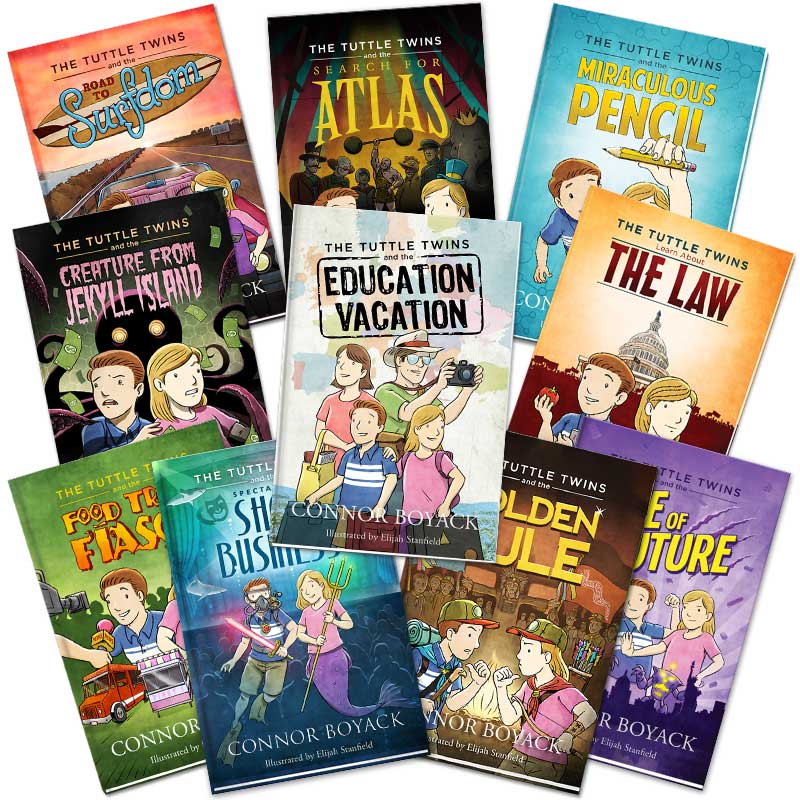Whenever my children express an interest in economics or are curious about the ideals of freedom and responsibility, I can barely contain my excitement. It wasn’t until college that I discovered, and fell in love with, economics, and it wasn’t until much later that I understood liberty as a life philosophy.
Fortunately, I can avoid stifling their budding interest by drawing demand curves or quoting Hayek and Hazlitt (though I’ve been known to do both!) and turn to some outstanding resources just for kids. Designed to introduce economic principles and the foundations of a free society to young children, these tools are interesting, engaging, and easy-to-understand—for children and adults alike!
The Tuttle Twins
The popular Tuttle Twins book series continues to grow, with 10 children’s books now available, as well as accompanying activity sheets and instructional materials. Created by Connor Boyack, a father who was disappointed by the dearth of good economic and civic content for kids, The Tuttle Twins series introduces concepts ranging from spontaneous order and how money works to individual rights and youth entrepreneurship. The latest book in the series, The Tuttle Twins and the Education Vacation, makes a case for non-coercive learning outside of the classroom.
These may seem like big ideas for small children, but Boyack says we underestimate children’s ability and interest. “I’ve been blown away at how well little kids can understand big ideas,” he says.
We get reviews from parents daily who are amazed at the same discovery and are thankful that their children are being introduced to ideas that most adults never learn.
Boyack recently launched Free Market Rules, a new weekly, family-centered curriculum for exploring free-market principles in greater depth, and FEE readers can use the coupon FORTY to get 40 percent off the Tuttle Twins books.
Nobody Know How to Make a Pizza
FEE’s founder, Leonard E. Read, wrote his famous essay, “I, Pencil,” in 1958, celebrating the miracle of the free market in facilitating voluntary exchange and producing the goods and services we want and need. This process happens spontaneously, without any central planner determining what to produce and how to produce it. Indeed, the remarkable message of “I, Pencil” is that “not a single person on the face of this earth knows how to make me.”
Now, author and economics commentator Julie Borowski offers a kid-friendly version of Read’s classic essay in her new book Nobody Knows How to Make a Pizza. Like a pencil, a pizza may seem simple to make, but it relies on millions of strangers working together peacefully and spontaneously to produce a basic cheese pizza. Borowski explains why she decided to write this book:
Over the years, many parents have told me that their kids enjoy listening to my commentary because I make learning about economics fun and simple. Some have asked if I would ever consider writing a children’s book. One day, I was re-reading Leonard Read’s “I, Pencil” when it hit me. It’s already a fascinating story, but can I make it more kid-friendly? I changed it to pizza cause, well, kids are more interested in pizza than pencils. And my illustrator, Tetiana Kopytova, did an amazing job creating cute characters with bright colors. It’s a fun, positive book that will revolutionize the way kids think about the world.
Sign-Up: Receive Kerry’s Weekly Parenting and Education Newsletter!
I Know My Rights: A Children’s Guide to the Bill of Rights and Individual Liberty
A 2017 survey by the University of Pennsylvania found that 37 percent of American adults couldn’t name one right protected by the First Amendment of the US Constitution, and only one-quarter of them could name all three branches of government. Clearly, there is a crisis in American civic education and a disturbing lack of understanding of individual liberty.
Author Rory Margraf wanted to address this problem by creating an accessible, colorful children’s book that easily explains the Bill of Rights and the principles of liberty to kids. He says:
I Know My Rights: A Children’s Guide to the Bill of Rights and Individual Liberty was inspired by research for an article while reflecting on the first time I was stopped by the authorities. The gap in civics knowledge, between both children and adults, indicated a crucial need for additional resources outside of brick-and-mortar schooling.
The book was so well-received that Margraf plans to release a sequel to I Know My Rights before the holidays. He adds:
I have found that the philosophy of liberty and the principles of free markets reach children extremely well.
FEE Resources
FEE also provides many high-quality resources to help young people expand their knowledge of economics and individual liberty. The free Invisible Hands video series for kids combines fun puppets and a famous YouTuber to offer an introductory look at basic economic principles. And for teenagers, FEE’s three-day summer seminars on college campuses across the country offer an opportunity for more in-depth exploration of these important ideas. Additionally, FEE’s free online courses on economics and entrepreneurship are great for people of all ages!
Parents are perfectly positioned to introduce economic and civic concepts to their children. In fact, they may be the best ones to do it. With authors now creating exceptionally good material for young children on these topics, it has never been easier or more enjoyable for parents to present these ideas to their kids and help them to deepen their knowledge throughout their teenage years.




